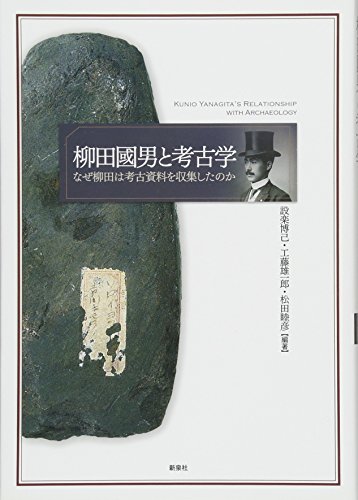13 0 0 0 OA 縄文時代のアサ出土例集成
- 著者
- 工藤 雄一郎 一木 絵理
- 出版者
- 国立歴史民俗博物館
- 雑誌
- 国立歴史民俗博物館研究報告 = Bulletin of the National Museum of Japanese History (ISSN:02867400)
- 巻号頁・発行日
- vol.187, pp.425-440, 2014-07-31
4 0 0 0 柳田國男と考古学 : なぜ柳田は考古資料を収集したのか
- 著者
- 設楽博己 工藤雄一郎 松田睦彦編著
- 出版者
- 新泉社
- 巻号頁・発行日
- 2016
2 0 0 0 鳥浜貝塚から出土したウルシ材の年代
- 著者
- 鈴木 三男 能城 修一 小林 和貴 工藤 雄一郎 鯵本 眞友美 網谷 克彦
- 出版者
- 日本植生史学会
- 雑誌
- 植生史研究 (ISSN:0915003X)
- 巻号頁・発行日
- vol.21, no.2, pp.67-71, 2012
Urushi is the lacquer produced by Toxicodendron vernici!uum. In Japan, Urushi products is known since ca. 9000 years ago from a remain at the Kakinoshima B site and became common since the early Jomon period. Archaeological woods of T. vernici!uum, however, had not been reported until ca. 10 years ago, when identi!cation of its woods from those of close allies was made possible. Since then, re-identi!caiton of excavated woods revealed that T. vernici!uum was commonly grown around settelments since the early Jomon period, but also indicated the existence of a sample of the incipient Jomon period from the Torihama Shell Midden site, Fukui Prefecture, which is too old to be considered as an introduction from the Asian continent to Japan. Here, we measured the radiocarbon age of this sample as 10,615 ± 30 14C BP (12,600 cal BP) in the incipient Jomon period, 3600 years before the oldest remain at the Kakinoshima B site. Most botanists consider that T. vernici!uum is not native and introduced to Japan by ancient people. Thus, the presence of T. vernici!uum wood in the incipient Jomon period seems to mean that Urushi was introduced from the Asian continent already in that period.
- 著者
- 工藤 雄一郎 一木 絵理
- 出版者
- 国立歴史民俗博物館
- 雑誌
- 国立歴史民俗博物館研究報告 = Bulletin of the National Museum of Japanese History (ISSN:02867400)
- 巻号頁・発行日
- vol.187, pp.425-440, 2014-07
1 0 0 0 百人町三丁目西遺跡出土隆起線文土器付着炭化物の年代と同位体分析
- 著者
- 工藤 雄一郎 米田 穣 大森 貴之
- 出版者
- 日本第四紀学会
- 雑誌
- 第四紀研究 (ISSN:04182642)
- 巻号頁・発行日
- pp.60.2020, (Released:2021-06-11)
- 参考文献数
- 47
本稿では,日本列島で最古段階となる縄文時代草創期の隆起線文土器群の年代的位置づけを検討するため,東京都百人町三丁目西遺跡出土土器内面付着炭化物の分析を行った.土器に付着した炭化物は少量であったが,炭素をセメンタイトに合成する微量分析による放射性炭素年代測定を実施し,12,660±50yrsBP(15,270~14,940calBP)の土器であることが分かった.また,炭素・窒素安定同位体分析により,炭化物の由来が陸上動植物であり,年代測定結果の信頼性が高いことを示した.隆起線文土器の土器付着炭化物の放射性炭素年代測定50点および最古段階の資料である長崎県福井洞窟3c層出土炭化材による隆起線文土器の年代を比較し,隆起線文土器は約16,000年前から2,000年程度続く土器型式であり,百人町三丁目西遺跡の土器はそのなかでも中段階に位置づけられることを示した.
1 0 0 0 OA 石器によるウルシ樹液採取実験
- 著者
- 千葉 敏朗 工藤 雄一郎 佐々木 由香 能城 修一
- 出版者
- 国立歴史民俗博物館
- 雑誌
- 国立歴史民俗博物館研究報告 = Bulletin of the National Museum of Japanese History (ISSN:02867400)
- 巻号頁・発行日
- vol.187, pp.479-489, 2014-07-31
1 0 0 0 OA 石川県御経塚遺跡から出土した縄文時代後・晩期土器の年代学的研究
- 著者
- 工藤 雄一郎 小林 謙一 山本 直人 吉田 淳 中村 俊夫
- 出版者
- 日本第四紀学会
- 雑誌
- 第四紀研究 (ISSN:04182642)
- 巻号頁・発行日
- vol.47, no.6, pp.409-423, 2008-12-01 (Released:2012-03-26)
- 参考文献数
- 48
石川県御経塚遺跡から出土した縄文時代後・晩期の土器付着物と漆の14C年代,炭素・窒素安定同位体比,C/N比の測定を行い,土器で煮炊きされた内容物と各土器型式の年代学的位置づけについて検討した.その結果,後期の内面付着炭化物は,動物資源を煮炊きしたものが炭化して残ったものと考えられ,このうちのいくつかは海洋リザーバー効果の影響を受けている可能性を指摘した.晩期の土器付着物の14C年代は,周辺地域の研究成果と対比しても整合的であった.そこで,晩期の土器付着物の14C年代をIntCal04で較正し,晩期中葉の中屋式,晩期後葉の下野式および長竹式の較正年代を提示した.晩期最終末の長竹式の年代は,北陸地域における環状木柱列の形成時期とも関係することが明らかとなり,これは縄文時代から弥生時代への移行期の問題を検討する上で,きわめて重要な成果である.
1 0 0 0 心・身体・社会をつなぐアート/技術
ヒトが生み出す物質文化には、身体機能の拡張を果たす技術と、感性や価値観にうったえてヒトの心を動かす芸術という二つの側面がある。本計画研究では、「アート」として包括されるその両面が身体を介して統合される様相に焦点を当て、日本列島、メソアメリカ、アンデス、オセアニアにおけるアートの生成と変容の特性を比較検討する。アート(技術・芸術)によるヒトの人工化/環境のヒト化という現象を、考古学的・人類学的・心理学的に分析することにより、社会固有のリアリティ(行動の基準となる主観的事実)が形成される歴史的プロセスを解明し、新たな人間観・文化観を提示することを目的とする。
1 0 0 0 OA 土器出現の年代と古環境 : 研究史の整理から
- 著者
- 工藤 雄一郎
- 出版者
- 国立歴史民俗博物館
- 雑誌
- 国立歴史民俗博物館研究報告 = Bulletin of the National Museum of Japanese History (ISSN:02867400)
- 巻号頁・発行日
- vol.178, pp.7-28, 2012-03-01
「縄文時代の始まり」あるいは「最古段階の土器」の研究は1950年代以降,¹⁴C年代測定と古環境研究の進展と常に密接に絡みながら進んできた。そこで本論では,これらが更新世/完新世(洪積世/沖積世),氷期/後氷期の境界,あるいは晩氷期と,どのように対比されてきたのかに注目して,戦前から現在までの研究の流れを整理した。縄文時代の始まりは沖積世の海進のピーク以後というのが戦前の一般的な地質時代観であったが,それが大きく変わる画期となったのが撚糸文土器の発見と夏島貝塚の¹⁴C年代測定であった。9,000年前を遡る土器と後氷期の開始が結び付けられ,考古学界には「後氷期適応論」が普及した。1963・1966年に公表された福井洞窟や上黒岩岩陰の¹⁴C年代は12,000年代まで遡り,氷期/後氷期の境界として認識されていた1万年前を超え,最古の土器を縄文時代から切り離す時代区分が提案されるきっかけとなるとともに,土器の出現と晩氷期との対比も始まった。1990年代になると,グリーンランド氷床コアなどの高精度の古環境研究が公開され,較正曲線IntCal93によって土器の出現が15,000年前まで遡る可能性が示されたが,決定的な画期となったのは1999年に公表された大平山元Ⅰ遺跡の較正年代であった。土器の出現が16,000年代まで遡るとともに,晩氷期を突き抜けて最終氷期の寒冷な環境下で土器が使用され始めたことが判明し,「土器出現の歴史的意義」と時代区分の画期としての土器の出現についても再検討が行われはじめた。2000年「佐倉宣言」以降は較正年代の理解とその使用が普及し縄文時代の始まりの年代と古環境との詳細な対比が行われるようになり,時代区分の再検討も進みつつある。
- 著者
- 工藤 雄一郎
- 出版者
- 国立歴史民俗博物館
- 雑誌
- 国立歴史民俗博物館研究報告 = Bulletin of the National Museum of Japanese History (ISSN:02867400)
- 巻号頁・発行日
- vol.187, pp.73-93, 2014-07
縄文時代の開始期の植物利用については,これまで土器の出現と関連づけて様々な議論が行われてきた。出現当初の縄文時代草創期の土器は「なにをどのように煮炊きするための道具だったのか」という点をより具体化し,列島内での土器利用の地域差などを検討していくことは極めて重要な研究課題である。2012年に発掘された宮崎県王子山遺跡からは,縄文時代草創期の炭化植物遺体(コナラ属子葉,ネギ属鱗茎)が出土した。筆者らは,これらの試料の炭素・窒素安定同位体分析を行い,また,王子山遺跡および鹿児島県三角山Ⅰ遺跡から出土した隆帯文土器の内面付着炭化物の炭素・窒素安定同位体分析を実施し,土器で煮炊きされた内容物について検討した。この結果,王子山遺跡では動物質食料と植物質の食料が煮炊きされていた可能性が高いことがわかった。王子山遺跡から出土した炭化ドングリ類は,土器による煮沸の行程を経てアク抜きをした後に食料として利用されていたというよりも,動物質の食料,特に肉や脂と一緒に煮炊きすることで,アク抜くのではなく,渋みを軽減して食料として利用していた可能性を提示した。一方,三角山Ⅰ遺跡では,隆帯文土器で海産資源が煮炊きされた可能性があることを指摘した。これらの土器の用途は,「堅果類を含む植物質食料のアク抜き」に関連づけるよりも,「堅果類を含む植物質食料および動物質食料の調理」と関連づけたほうが,縄文時代草創期の植物利用と土器利用の関係の実態により近いと推定した。Thus far, plant use during the Incipient Jomon period has been discussed in relation to the beginning of pottery use. This is because initial pottery-making is thought to have enabled the use of a number of vegetable foods found in cool to temperate, deciduous broadleaf forests, such as nuts and acorns that require boiling to remove toxins before consumption. However, clarifying "what kind of foods were actually processed or cooked in Incipient Jomon potteries" is one of the most important research topics.In 2012, charred acorns (Quercus subgen. Lepidobalanus) and bulbs of wild onion (Allium sp.) from the Incipient Jomon period were excavated from the Ojiyama Site, and directly dated to 13,400 cal BP. These discoveries indicate that people in the southern part of Kyushu Island already utilized these types of plant foods.In addition, in order to examine actual usage of the Ryutaimon pottery and to estimate its relationship with plant foods, carbon and nitrogen stable isotope values and C/N ratios of these plant remains and charred materials attached to the inside of Ryutaimon pottery from the Ojiyama Site (southern Kyushu Island) and Sankakuyama Site (Tanega-shima Island) were analyzed.Stable isotope values seem to show that Ryutaimon pottery from the Ojiyama Sites was used not only for boiling plants (especially acorns), but also for boiling remains of terrestrial mammals. The charred materials on potteries might be residue of a mixed "stew" of plant and animal foods. In the case of the Sankakuyama Site, stable isotope values were related more closely to marine products. It is likely that Ryutaimon pottery on southern Kyushu Island was used as a cooking tool for boiling a wide variety of foodstuffs.
1 0 0 0 OA 遺跡出土植物遺体データベースの構築に基づく生業形態と植物分布変遷との関係の解明
第20回名古屋大学年代測定総合研究センターシンポジウム平成19(2007)年度報告<第2部> Proceedings of the 20th symposiumon on Chronological Studies at the Nagoya University Center for Chronological Researchin 2007 日時:平成20 (2008)年1月10日(木)~11日(金) 会場:名古屋大学野依記念学術交流館 Date:January10th-11th, 2008 Venue:Nagoya Uhiversity Noyori Conference Hall

